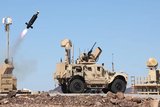How do we detect and defeat enemy drones?
Learn about the portfolio of sensors and effectors for the complete counter-UAS mission at Raytheon, an RTX business.
Northrop Grumman have been awarded a three-year development contract for GPI. (Image: Northrop Grumman)
The US Missile Defense Agency (MDA) has selected Northrop Grumman for a three-year development GPI programme to create a system capable of defeating existing and emerging hypersonic threats.
Northrop Grumman was selected for GPI over Raytheon (RTX) and will work with the US in support of its role under the GPI Cooperative Development (GCD) programme with the Japan Ministry of Defence to deliver interceptors to the MDA.
In May, Japan and the US finalised a formal agreement for a GCD Project Arrangement under the US-Japan bilateral Memorandum of Understanding for Research, Development, Test and Evaluation Projects.
Several companies obtain hypersonic contracts
Glide Phase Interceptor passes Systems Requirements Review milestone
US Missile Defense Agency’s budget could be cut by $2.6 billion over the next three years
Under the GPI development effort, Northrop Grumman will continue to refine the preliminary design of the system, demonstrate system performance in hypersonic environments prior to conducting its Preliminary Design Review and complete flight experiments.
In addition, the company will use digital engineering practices to connect the entire GPI programme to accelerate design processes and develop interceptor capabilities faster and more efficiently.
MDA director Lt Gen Heath Collins described the contract as “a turning point for hypersonic glide phase defence”.
The programme has moved rapidly with MDA awarded three agreements in support of the GPI in 2021 and inn June 2022 MDA exercised two of those three agreement options to continue development of GPI.
MDA retained two concepts throughout the Systems Requirement Review and received approval in April 2023 to progress from Material Solutions Analysis phase to Technology Development phase and to finally this announced selection.
The Pentagon is betting big on GPI and hypersonic programmes such as the Aegis Weapon System, Hypersonic Attack Cruise Missile, Hypersonic and Ballistic Tracking Space Sensor, Long Range Hypersonic Weapon and Long Range Stand Off/Hypersonic Attack Cruise Missile.
The Pentagon requested US$7 billion for these programmes in its FY2025 budget request but it is possible this figure may not be met.

Learn about the portfolio of sensors and effectors for the complete counter-UAS mission at Raytheon, an RTX business.

The US-based tests successfully demonstrated the first live trial of a precision guided missile from a modified TRV-150 drone which destroyed both aerial and ground targets.

India’s stealth fighter ambitions gain fresh momentum as HAL opens the door to private sector involvement in AMCA Mk1A structural assembly, with strategic support growing for next-gen propulsion and sensor technologies.

A key part in the trinational Global Combat Air Programme (GCAP), this is the first crewed supersonic aircraft demonstrator to be built and developed in the UK in more than 40 years.

Kratos’ XQ-58A Valkyrie will be equipped with an Airbus-made mission system to be offered as a ‘European’ collaborative combat aircraft option to the German Air Force.

The munitions variant of the Barrauda-100 autonomous air vehicle is being tested for the US Army’s High-Speed Manoeuvrable Missile (HSMM) testbed programme, with further flight tests expected in 2026.